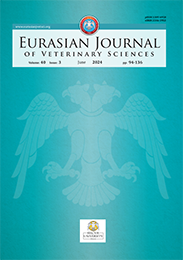| 2012, Cilt 28, Sayı 3, Sayfa(lar) 149-153 |
| [ Türkçe Özet ] [ PDF ] [ Benzer Makaleler ] |
| The effect of gonadotropin-releasing hormone or human chorionic gonadotropin administration at mating on lambing performance in Konya Merino yearling ewes |
| Mehmet Köse1,2, Ahmet Hamdi Aktaş2, Mesut Kırbaş2, Bülent Bülbül2 |
| 1Dicle Üniversitesi, Veteriner Fakültesi, Doğum ve Jinekoloji Anabilim Dalı, Diyarbakır, Türkiye 2Bahri Dağdaş Uluslararası Tarımsal Araştırma Enstitüsü, Konya, Türkiye |
| Keywords: Konya Merino, yearling ewes, GnRH, hCG, lambing performance |
| Downloaded:1960 - Viewed: 3401 |
|
Aim: In this study, it was aimed to determine the effects of
the exogenous gonadotropin-releasing hormone (GnRH) or
human chorionic gonadotropin (hCG) application at mating
on lambing performance in synchronization and following
cycle in Konya Merino yearling ewes.
Materials and Methods: Thirty six yearling Merino ewes, aging 16-20 months, were used as material. Estrus of ewes was synchronized with 4 μg GnRH on d 0 and 150 μg prostaglandinF2α (PGF2α) on day 5, intramuscularly. After PGF2α injection, the ewes detected to be in estrus were mated with a ram, whose fertility was known previously, and they were divided into three groups. Group I (n=14) were injected 200 IU hCG, Group II (n=12) were injected 4 μg GnRH, and Group III (control group, n=10) were injected 1 mL placebo at mating. Pregnancy was diagnosed on day 30 by using transrectal ultrasonography. Results: In the present study, pregnancy, birth, twinning rate and lambing performance were 85.71%, 85.71%, 33.3% and 1.14 in hCG group, 75.0%, 66.67%, 12.5%, and 0.75 in GnRH group, and 100%, 80%, 37.5% and 1.10 in control group, respectively. There was no significant difference among groups for lambing performance and studied reproductive parameters (p>0.05). Conclusion: In conclusion, the injection of GnRH or hCG in Merino ewes at mating was not effective on lambing performance. |
| [ Türkçe Özet ] [ PDF ] [ Benzer Makaleler ] |





